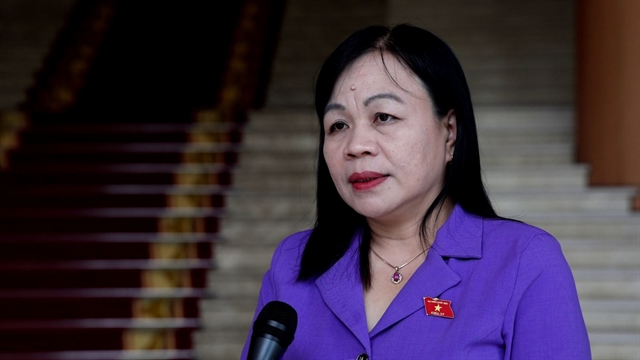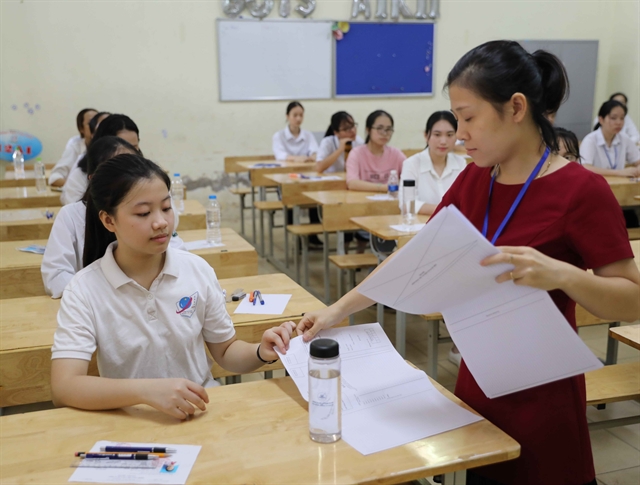 Opinion
Opinion

Nguyễn Thị Mai Hoa, deputy head of the National Assembly's Committee for Culture and Education, spoke with the online newspaper Tin tức (News) about the shortage of public high schools in major cities.

|
| Nguyễn Thị Mai Hoa, deputy head of the National Assembly's Committee for Culture and Education. - VNA/VNS Photos |
For the academic year 2024 - 2025, Hà Nội is expected to have more than 51,000 students unable to enrol in public high schools. Nguyễn Thị Mai Hoa, deputy head of the National Assembly's Committee for Culture and Education, spoke with the online newspaper Tin tức (News) about this issue.
Parents lining up for many hours to find a place for their children in private schools after failing to get into public high schools is an increasingly common situation in big cities. Can you tell us the reasons for this situation?
The first reason is the issue of supply and demand. The demand for children to complete secondary education is very high. Still, since high school is not compulsory education, the public high school system can only accommodate around 60 to 70 per cent of students admitted to grade 10. Thus, every year there will be about 30 – 40 per cent of students who will not have a place in public high schools.
For the academic year 2023-2024, it is estimated that the whole city will have about 133,000 students graduating from secondary education. According to the plan approved by the city People's Committee, the expected quota for enrolment in public schools is about 81,200 students. The remaining 51,800 students will be admitted to private schools, vocational or continuing education centres.
The second reason is that we are implementing the diversification policy after secondary education, whereby students will have many other options besides continuing to high school. However, many parents still want their children to complete the general education programme.
The third reason is that the conditions provided in the public high school system are quite good, as they are funded from the State budget while the difference in tuition fees between public and private schools is often huge. The desire for children to attend public schools to have more affordable tuition fees is a legitimate aspiration, especially for economically disadvantaged families.
As the population density in major cities like Hà Nội and HCM City continues to be high, the pressure for increased capacity at public schools will increase. Although Hà Nội has conducted reviews and implemented solutions such as dividing classes and growing class sizes, these are only temporary solutions to the current situation.
What are the fundamental solutions to address this issue?
This is indeed a difficult problem, and addressing it only by increasing classes and student numbers can only be a short-term solution.
Comprehensive and coordinated planning is needed in the long run. For large cities, urban development planning must be synchronised with education and healthcare services to meet the population's educational and healthcare needs.
Secondly, it is necessary to improve the data system to have rational regulation in education investment. For example, rural areas are currently experiencing the trend of merging schools and classes due to the increasing number of labourers migrating from rural to urban areas, leading to a gradual shift in demand for educational services towards urban areas.
Therefore, it is necessary to consider regulatory solutions for teachers and investment in infrastructure, transferring schools and classes from rural to urban areas. This means there must be a data system for careful analysis and forecasting to solve this problem.

|
| Students take the national high school graduation exam in Hà Nội. |
Thirdly, it's about streamlining. This is a correct policy. In developed countries, streamlining is relatively easy. It is necessary to persuade people that their children have more choices in their education. However, to achieve this, there must be a system of high-quality vocational schools and a diverse labour market, ensuring stable and sustainable incomes.
If the target of streamlining into vocational schools is achieved by limiting students’ access to public high schools, this policy will not be effective. Worse, it may even affect students' right to complete high school education.
In addition, to reduce the pressure on public schools, we need to mobilise social resources more effectively to develop a system of non-public high schools for different segments, including high-quality private schools with varying tuition fees.
The key is that the State must take responsibility for investing in policy mechanisms and resources to develop an education system that ensures quality and meets human resource needs. The State also needs to encourage the expansion of the labour market with various segments. At the same time, it should communicate well to change the public perception about education, training, and employment.
I believe it is necessary to implement many synchronised solutions with the participation of the State, localities, educational institutions and students’ families. Only then can we fundamentally solve the pressure on admission to public high schools as in recent years.
What specific actions has the National Assembly’s Committee for Culture and Education taken to implement the fundamental solutions mentioned above?
During this period, we have focused on monitoring the implementation of legal provisions in the field of education. Our monitoring activities have revealed some difficulties and obstacles, such as the issue of forecasting the demand for school places.
According to statistics, as of June 1, 2023, the population of HCM City is nearly 8.9 million people. If we include those who reside without registering their households, the city's population reaches almost 14 million. Therefore, the data did not accurately reflect the reality of the population, making it difficult to forecast the needs for school planning and ensure sufficient places for preschool and general education.
The committee has made many recommendations and proposals to the government, state management agencies, and local authorities regarding the implementation of the education law and the vocational education law. Additionally, the committee has participated in improving the legal system and policies regarding education, prioritising budget investment, credit policies, tuition fee policies, and institutionalising the policy of socialisation of education with preferential tax and land policies to create conditions for developing private schools to better meet the needs of students. — VNS




